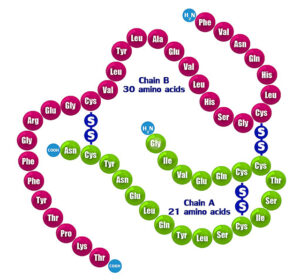INSULIN AND GLUCAGON: THE DYNAMIC DUO OF BLOOD GLUCOSE REGULATION

Most people have heard of insulin and have a rough understanding of its essential functions. The same cannot be said about glucagon, however. Both are secreted by the pancreas, an un-loved but vital organ.
The pancreas
The pancreas is located behind the stomach in the upper left part of the abdomen. It is surrounded by other organs including the stomach, small intestine (duodenum), liver, and spleen. It is spongy, about 15–25cm (6–10in) long, 2.5cm (1in) thick, and is shaped a bit like a flattened pear or a fish extended horizontally across the abdomen. The bulk (95%) of the pancreas consists of tissues and cells that produce pancreatic secretions for the digestion of carbohydrates, fats and proteins. The remainder consists of little islands of cells called islets of Langerhans. These look a bit like small bunches of grapes and produce hormones that regulate blood glucose and help regulate pancreatic digestive secretions.
Blood glucose hormones
Two of the most important pancreatic hormones are insulin produced by beta cells and glucagon produced by alpha cells in the islets of Langerhans which manufacture and release these hormones directly into the bloodstream.
Insulin
Insulin is a di-peptide (i.e., protein) hormone that maintains normal blood glucose levels by facilitating cellular glucose uptake, regulating carbohydrate, lipid and protein metabolism and promoting cell division and growth. It contains A and B chains respectively, linked by disulphide bridges, and contains a total of 51 amino acids.
Because it is a protein, it cannot be given by mouth as it will be broken down into its constituent amino acids in the stomach and small intestine. Hence the need for insulin to be injected into the skin by those who are deficient in the hormone.
Insulin regulates the metabolism of carbohydrates, fats and protein by promoting the absorption of glucose from the blood into liver, fat and muscle cells. In these cells the absorbed glucose is converted into either glycogen (a kind of starch found in the liver and muscles) via a process known as glycogenesis or fats (triglycerides) via lipogenesis. Circulating insulin also affects the synthesis of proteins in a wide variety of cells and tissues. It is therefore an anabolic hormone, promoting the conversion of small molecules in the blood into larger molecules inside the cells.
Glucagon
Glucagon stimulates the liver to break down glycogen into glucose, which is then released into the blood. It also activates gluconeogenesis, the conversion of certain amino acids from proteins into glucose. Finally, it facilitates the breakdown of stored fat (triglycerides) into fatty acids for use as fuel by cells. It is therefore a catabolic hormone, promoting the breakdown of large molecules in cells and organs into smaller molecules in the blood.
Insulin and Glucagon in harmony together
Pancreatic beta cells are sensitive to blood glucose concentrations. When glucose levels are high, they secrete insulin into the bloodstream and when glucose levels are low, secretion of insulin is inhibited. On the other hand, alpha cells secrete glucagon into the blood in the opposite manner to insulin: when blood glucose levels are low, or in response to vigorous exercise, secretion is increased, and when blood glucose levels are high, secretion is decreased.
The secretion of insulin and glucagon into the blood in response to changes in blood glucose concentrations is the primary mechanism of blood glucose homeostasis. In other words, the two hormones work in partnership with each other to keep blood glucose levels balanced.
Diabetes
If the beta cells are destroyed by an autoimmune response, insulin can no longer be synthesized or secreted into the blood in sufficient quantities. This results in the development of type 1 diabetes.
In type 2 diabetes, the destruction of beta cells is less pronounced than in type 1 diabetes and is not primarily due to an autoimmune process. The exact cause of type 2 diabetes is not fully understood but people have a reduced number of islet beta cells, and of those that survive there is a reduced secretory function, and there is also frequently (but not always) peripheral tissue insulin resistance (the insulin that is produced does not work as efficiently in the target cells as it should). Type 2 diabetes is also characterized by high rates of glucagon secretion which are less responsive to the concentration of glucose in the blood, but insulin is still secreted into the blood in response to concomitantly increasing blood glucose concentrations. As a result, insulin levels are typically much higher than they are in people without type 2 diabetes.
Optimal maintenance of blood glucose levels is critical to the functioning of key organs including the brain and nervous system, liver, and kidneys.
Read more:
-
Wilcox. Insulin and insulin resistance. Clin Biochem Rev. 2005
-
Rix and colleagues. Glucagon Physiology. [Updated 2019 Jul 16]. In: Feingold and colleagues, editors. Endotext [Internet]. South Dartmouth (MA): MDText.com, Inc.; 2000-.








